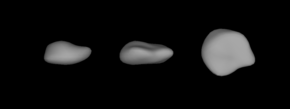astro.wikisort.org - Astéroïde
(135) Hertha est un astéroïde de la ceinture principale découvert par Christian Peters le .
Pour les articles homonymes, voir Hertha.
(135) Hertha

Reconstitution de la forme de l'astéroïde par inversion de sa courbe de lumière.
| Demi-grand axe (a) |
363,269 × 106 km (2,428 ua) |
|---|---|
| Périhélie (q) |
288,275 × 106 km (1,927 ua) |
| Aphélie (Q) |
438,264 × 106 km (2,930 ua) |
| Excentricité (e) | 0,206 |
| Période de révolution (Prév) |
1 382,119 j (3,784 a) |
| Vitesse orbitale moyenne (vorb) | 18,91 km/s |
| Inclinaison (i) | 2,305° |
| Longitude du nœud ascendant (Ω) | 343,902° |
| Argument du périhélie (ω) | 340,077° |
| Anomalie moyenne (M0) | 115,808° |
| Catégorie |
ceinture d'astéroïdes (Nysa) |
| Dimensions | 79,2 km [1] |
|---|---|
| Masse (m) | 5,21 × 1017 kg |
| Masse volumique (ρ) | ~2 000 kg/m3 |
| Gravité équatoriale à la surface (g) | 0,022 2 m/s2 |
| Vitesse de libération (vlib) | 0,041 9 km/s |
| Période de rotation (Prot) |
0,350 0 j (8,401 h) |
| Classification spectrale | M |
| Magnitude absolue (H) | 8,23 |
| Albédo (A) | 0,144 [1] |
| Température (T) | ~176 K |
| Date | |
|---|---|
| Découvert par | Christian Peters |
| Nommé d'après | Herta (mythologie) |
| Désignation | A874 DA |
Il fut nommé après Herta en mythologie celtique.
Références
- « IRAS » (version du 24 février 2005 sur l'Internet Archive)
Voir aussi
Articles connexes
- Liste des planètes mineures (1-1000)
Lien externe
- (en) Caractéristiques et simulation d'orbite de 135 sur la page Small-Body Database du JPL. [java]
- Portail de l’astronomie
- Portail des planètes mineures et comètes
На других языках
[de] (135) Hertha
(135) Hertha ist ein Asteroid des inneren Asteroiden-Hauptgürtels, der am 18. Februar 1874 von Christian Heinrich Friedrich Peters entdeckt wurde.[en] 135 Hertha
Hertha (minor planet designation: 135 Hertha) is an asteroid from the inner region of the asteroid belt, approximately 77 kilometers (48 miles) in diameter. Discovered on 18 February 1874 by German–American astronomer Christian Peters at the Litchfield Observatory near Clinton, New York,[1] it was named after the Teutonic and Scandinavian goddess of fertility, Hertha, also known as Nerthus.[2] It orbits among the Nysa asteroid family, but its classification as a metallic M-type asteroid does not match the more common F-type asteroid for this family, suggesting that it may be an interloper.[9] Spectroscopic analysis indicates the possible presence of hydrated silicates indicating that Hertha should possibly be reclassified from its present M-type to the proposed W-type.[10][es] (135) Hertha
(135) Hertha es un asteroide que forma parte del cinturón de asteroides y fue descubierto el 18 de febrero de 1874 por Christian Heinrich Friedrich Peters desde el observatorio Litchfield de Clinton, Estados Unidos. Está nombrado por Herta, otro nombre de la diosa de la mitología nórdica Nerthus.[2]- [fr] (135) Hertha
[ru] (135) Герта
(135) Герта (нем. Hertha) — астероид главного пояса, который по орбитальным параметрам близок к астероидам семейства Нисы, но не входит в него, поскольку принадлежит к железным астероидам спектрального класса M, в то время как в данное семейство входят астероиды класса S и класса F. Данные спектроскопического анализа говорят о возможности наличия водных силикатов на данном астероиде.Текст в блоке "Читать" взят с сайта "Википедия" и доступен по лицензии Creative Commons Attribution-ShareAlike; в отдельных случаях могут действовать дополнительные условия.
Другой контент может иметь иную лицензию. Перед использованием материалов сайта WikiSort.org внимательно изучите правила лицензирования конкретных элементов наполнения сайта.
Другой контент может иметь иную лицензию. Перед использованием материалов сайта WikiSort.org внимательно изучите правила лицензирования конкретных элементов наполнения сайта.
2019-2025
WikiSort.org - проект по пересортировке и дополнению контента Википедии
WikiSort.org - проект по пересортировке и дополнению контента Википедии